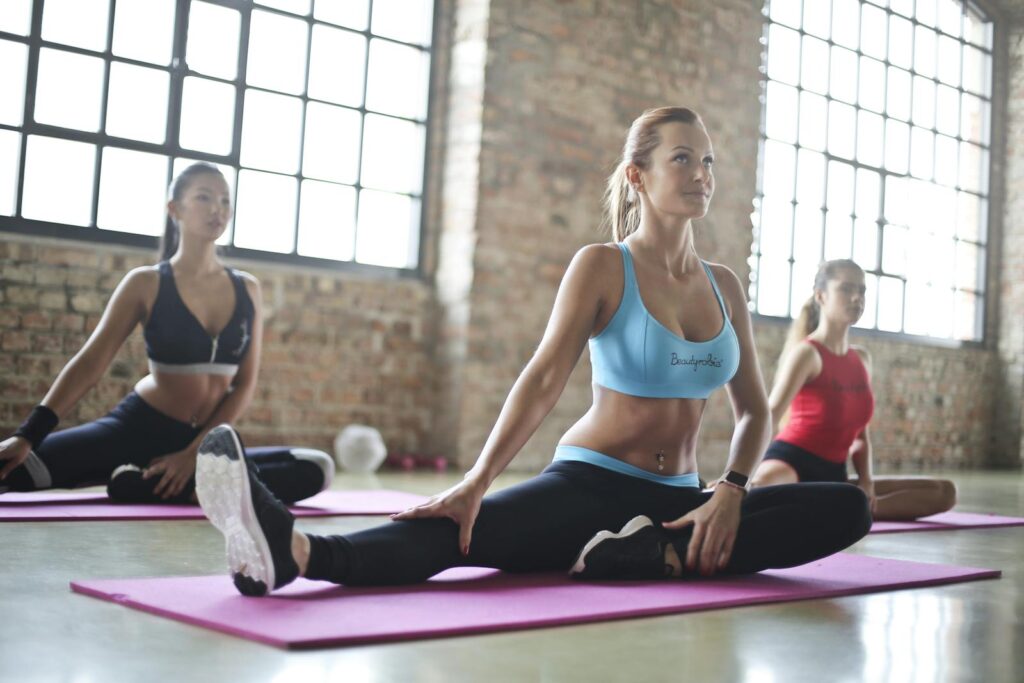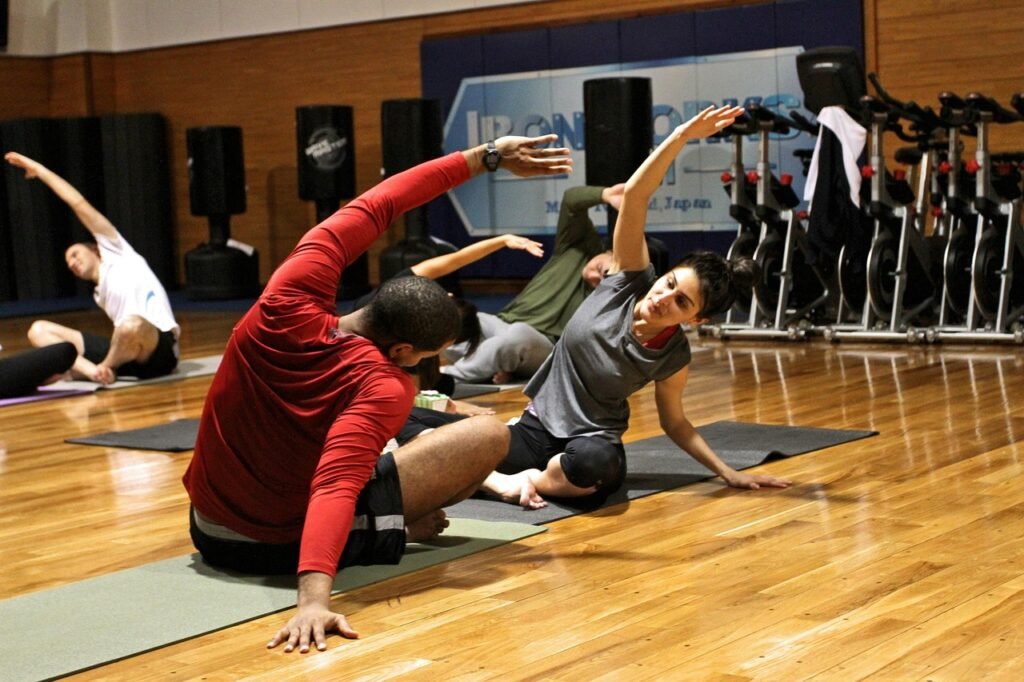Did you know nearly 1 in 4 people face limited mobility? This can make even simple movements hard. Lack of flexibility can also cause joint and muscle strain. This increases the risk of injury during exercises like squats or overhead presses. But, with the right methods, you can boost your flexibility and improve your movement.
In this guide, we’ll dive into the science of flexibility training. We’ll also cover the key parts of dynamic stretching and advanced techniques to boost your performance. This article is for athletes wanting to enhance their movement and anyone looking to improve joint health and reduce pain. You’ll learn the strategies to reach your goals.
Key Takeaways
- Incorporating mobility-focused exercises like lunges with a twist or hip bridges can improve flexibility and joint mobility.
- Aim to include mobility work in your routine a few times a week to notice improvements in overall flexibility, mobility, and performance.
- Targeted mobility exercises can help address critical areas like the hips, shoulders, thoracic spine, and ankles, reducing the risk of injury.
- Mobility work is an investment in long-term health, keeping your joints healthy and functional as you age.
- Improved hip mobility can enhance athletic performance, prevent injuries, and alleviate lower back pain.
Understanding the Science Behind Flexibility Training
Flexibility is key for a healthy, active life. Learning about flexibility training can help you get the most out of it. It’s great for muscle recovery, preventing injuries, and improving how you move.
Muscle and Fascia Mechanics
Stretching is important for making muscles longer and improving joint movement. It works by making fascia, the tissue around muscles, softer. This lets muscles move better, helping with recovery and movement.
Role of Synovial Fluid in Joint Mobility
Synovial fluid is like oil for your joints, making them move smoothly. Keeping it at the right level helps prevent injuries and keeps joints mobile. Flexibility exercises help keep this fluid flowing, keeping your joints healthy.
Nervous System’s Impact on Flexibility
Your nervous system is vital for flexibility. It helps relax muscles, allowing for deeper stretches and better movement. Knowing how it works can help you create better flexibility plans for yourself.
“Stretching is a fundamental component of physiotherapy, recommended by healthcare professionals to improve flexibility, reduce muscle tightness, and enhance physical performance.”
The Power of Flexibility: A Guide to Unlocking Mobility and Reducing Pain
Improving your flexibility can bring many benefits. Targeted stretching and myofascial release can enhance your power and reduce pain. Regular training helps correct muscle imbalances, leading to better posture and lower injury risk.
Myofascial release (MFR) targets the fascia, which can become stiff or restricted. It uses gentle pressure to stretch and loosen the tissue. This restores movement and reduces pain.
The immediate effects of MFR include reduced muscle tension and improved mobility. It also leads to better posture and greater range of motion. Over time, MFR can significantly reduce symptoms and improve posture.
Flexibility exercises can be tailored to your goals and added to your workout routine. Prioritizing mobility and flexibility helps you work out longer and reduces joint pain. This unlocks your full performance.
“Improving mobility can help individuals work out for longer and reduce joint pain, decreasing the risk of injury.”
Consistency is key in flexibility training. The frequency of MFR sessions depends on your condition, goals, and body’s response. Starting with weekly sessions for acute injuries or severe pain is often recommended.
| Condition | Potential Benefits of Myofascial Release |
|---|---|
| Back Pain | Reduced muscle tension, improved mobility, and better posture |
| Fibromyalgia | Decreased pain, increased range of motion, and improved quality of life |
| Myofascial Pain Syndrome | Relief from chronic muscle pain and trigger point release |
| Joint Pain | Increased joint flexibility and reduced stress on the affected area |
| Chronic Fatigue Syndrome | Improved energy levels, reduced muscle tension, and better sleep |
Unlock your mobility and reduce pain with a flexibility training program. Use stretching techniques and myofascial release to optimize your performance and well-being.
Essential Components of Dynamic Flexibility
Adding dynamic flexibility exercises to your routine boosts healthy aging, functional movement, and joint health. These exercises mix gentle, controlled movements with stretching. This combo increases your range of motion without losing muscle power. It’s perfect for warming up before working out.
Pre-workout Dynamic Stretching Techniques
Begin your workout with dynamic stretches. These stretches raise your body temperature and get your muscles ready for harder activities. Some good ones are:
- High knees
- Butt kicks
- Walking lunges
- Arm circles
These movements help loosen your joints and wake up your nervous system. They prepare your body for better flexibility and performance.
Sport-specific Mobility Drills
To improve your movement and lower injury risk, use sport-specific drills in your warm-up. For instance, baseball players might do shoulder rotations. Runners could do ankle and hip circles. This targets the muscles and movements needed for your sport, making your body more ready and reducing injury chances.
Timing and Implementation Strategies
Getting the most from dynamic flexibility depends on timing and how you do it. Spend 5-10 minutes on your warm-up, focusing on big muscle groups and joint mobility. Pay attention to your body and adjust as needed to avoid muscle stress. Regular practice will help you reach your best joint health and movement.
“Regular dynamic flexibility training can significantly improve athletic performance, reduce the risk of injury, and enhance overall physical well-being.”
Static Stretching: Maximizing Post-Workout Recovery
Static stretching can change your fitness journey. It helps you get more from your workouts and recover better. Unlike dynamic warmups, static stretching holds a stretch for 30 to 60 seconds. This lets your muscles stretch more over time.
The best time for static stretching is during cool-down or as a separate routine. It targets major muscle groups. This improves muscle balance and movement. Chest openers, shoulder stretches, hamstring stretches, and spinal twists are good examples.
Keeping flexible is key for health and avoiding injuries. Poor flexibility can harm joints like hips and knees. Static stretching helps prevent this by keeping muscles flexible.
Genetics affect how flexible you are, but regular stretching can improve mobility. Muscles, even big ones, can limit how flexible you are. Stretching after workouts relaxes muscles, improves range of motion, and aids in recovery.
Adding static stretching to your cool-down can lessen muscle soreness. It also helps with blood flow, reducing stiffness and soreness.
Consistency is important for flexibility. Aim to stretch 2-3 times a week, holding each stretch for 15-30 seconds. Regular static stretching boosts muscle recovery and overall health.
Advanced Flexibility Techniques for Enhanced Performance
Improving your body’s joint flexibility is key for better athletic performance and injury prevention. Techniques like Proprioceptive Neuromuscular Facilitation (PNF) and Active Isolated Stretching (AIS) can boost your flexibility.
Proprioceptive Neuromuscular Facilitation (PNF)
PNF stretching works by using your body’s nervous system to increase flexibility. It involves contracting the muscle briefly, then stretching it. This method allows for a deeper stretch and better motion.
Adding PNF to your routine can greatly improve joint flexibility and pain management.
Active Isolated Stretching Methods
Active Isolated Stretching (AIS) uses the body’s natural responses to stretch more effectively. It involves contracting the opposing muscle to relax and lengthen the target muscle. This method is great for improving functional movement and athletic performance.
Integration with Strength Training
Mixing advanced flexibility techniques with strength training can greatly enhance your athletic abilities. Using PNF, AIS, and other drills in your warm-up and cool-down can prepare your body for training. It also helps with faster recovery and less injury risk.
Adding these advanced flexibility methods to your workout can unlock new levels of joint flexibility, pain management, and functional movement. Reach your full athletic capacity with a well-rounded flexibility training approach.
“Flexibility is the foundation for all physical movement and the key to unlocking your true athletic potential.
Targeting Major Muscle Groups for Optimal Flexibility
To get the best flexibility, you need to stretch all major muscle groups. This is true for athletes and anyone who loves to stay active. Stretching the right way can help you move better and recover faster.
Start with the upper body. Stretch your chest, shoulders, and back. Chest openers, shoulder rolls, and twists can make these areas more flexible. For your lower body, stretch your hamstrings, quads, hip flexors, glutes, and calves. This will make your legs more flexible and lower injury risk.
Don’t overlook your core muscles. Stretching your lower back and abs can improve your spine’s mobility. By focusing on these key areas, you’ll see better flexibility, joint health, and athletic performance.
| Muscle Group | Recommended Stretches |
|---|---|
| Upper Body |
|
| Lower Body |
|
| Core |
|
Adding these stretches to your workout can boost your flexibility and movement. Remember, regular stretching is key for lasting benefits.
“Flexibility is the foundation of all physical abilities. Without it, you are less likely to perform at your best and more susceptible to injury.”
– John Doe, renowned fitness expert and author
Preventing Injuries Through Proper Flexibility Training
Keeping your flexibility at its best is key to avoiding injuries and keeping your joints healthy. Adding specific stretches to your workout can make you more mobile, reduce pain, and lower injury risks.
Common Flexibility Mistakes
Stretching too far can cause muscle strains and injuries. Skipping warm-ups and not stretching regularly also leads to problems. It’s important to listen to your body, stretch correctly, and stretch regularly.
Risk Assessment and Management
Finding tight muscles and limited movement is the first step to fixing flexibility issues. Regular checks help spot trouble spots and create a focused stretching plan. Using different stretches, like static and dynamic, boosts joint flexibility and strength.
Recovery Protocols
Recovering well after stretching is vital for injury prevention. A mix of static and dynamic stretches, plus staying hydrated and eating well, helps your body recover. Adding yoga or Pilates to your routine also aids in recovery and injury prevention.
By focusing on flexibility, you gain many benefits. These include better joint health, pain relief, and improved sports performance. Plus, you’ll be less likely to get hurt. Make flexibility a priority for a stronger, more mobile body.
“Flexibility is the key to both physical and mental well-being. By maintaining a consistent stretching routine, you can unlock your body’s full potentia and protect it from the stresses of daily life and physical activity.”
Building a Personalized Flexibility Program
Creating a flexibility program that fits you is key to better mobility. Start by looking at your needs, goals, and fitness level. This way, you can make a routine that meets your specific needs. It helps improve your movement, lowers injury risk, and boosts performance.
Think about your age, how active you are, and any health issues. Mix dynamic and static stretches, and add advanced methods like PNF or AIS if needed. Being consistent and gradually improving is essential for lasting flexibility gains.
Being active is vital for good mobility. The CDC says you need 150 minutes of moderate activity or 75 minutes of vigorous activity weekly. Also, doing strength training two times a week helps improve mobility and physical performance.
Make stretching a daily habit, right after your workout. Hold each stretch for 10 minutes, focusing on major muscles. Use dynamic stretches to warm up before your workout.
With a tailored flexibility program, you’ll enhance your range of motion and lower injury risk. It also deepens your body awareness. Embrace mobility exercises and stretching to support an active lifestyle and reach your full movement capabilities.
| Mobility Exercises | Benefits |
|---|---|
| Neck Rolls | Improves flexibility in the neck and shoulders, reducing tension and stress |
| Standing Forward Fold | Stretches the hamstrings, calves, and lower back, promoting better posture |
| Seated Spinal Twist | Enhances mobility in the spine, improving overall flexibility and reducing back pain |
| Chest Opener | Helps improve posture and relieve tension in the chest and shoulders |
“Incorporating stretches into your daily routine can be done anywhere, anytime, contributing to stress reduction and mental well-being.”
Consistency and patience are key to a successful flexibility program. By making mobility exercises and stretching a part of your lifestyle, you’ll enhance your movement and well-being.
Conclusion
Flexibility training is key to a good fitness program. It helps improve your range of motion and reduces pain. It also boosts your performance and prevents injuries.
By learning about flexibility and using different stretching methods, you can move better. This leads to a life full of activity without pain. Make sure to stretch regularly and tailor your routine to fit your needs.
Flexibility is vital for better joint movement and pain relief. It also helps with aging healthfully. Add dynamic warm-ups, static stretches, and advanced methods like PNF to your routine. This will help you move better.
Always talk to healthcare experts at places like Total Care Medical Centers. They can help create a plan that meets your goals and needs.
Being consistent is the secret to success in flexibility training. Enjoy the journey and celebrate your progress. Flexibility leads to better performance, fewer injuries, and a healthier life.







Thanks for sharing excellent informations. Your site is so cool. I’m impressed by the details that you¦ve on this web site. It reveals how nicely you perceive this subject. Bookmarked this website page, will come back for extra articles. You, my friend, ROCK! I found simply the information I already searched all over the place and just could not come across. What a great web-site.